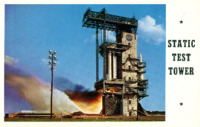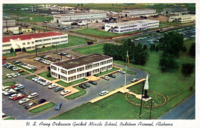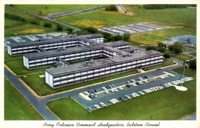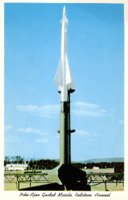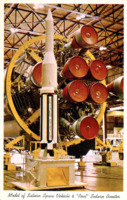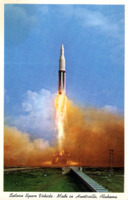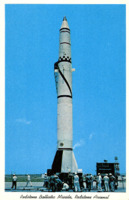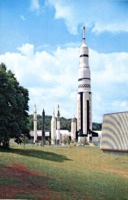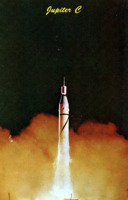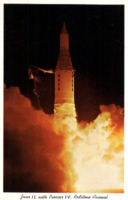
Browse Items (4796 total)
Sort by:
-
Static Firing Test Tower
Front: Static Test Tower.
Back: STATIC FIRING TEST TOWER, MARSHALL SPACE FLIGHT CENTER
The Saturn booster undergoes static firing at the NASA George C. Marshall Space Flight Center, Huntsville, Alabama. The booster has been successfully static fired many times prior to the launching of the first Saturn from Cape Canaveral, Florida on October 27, 1961. The same tower has been used for Redstone and Jupiter programs. Static testing of a missile consists of locking the missile into place on the stand and firing it. The missile does not "take off", but as it strains against the mighty grip of the great tower its roaring engine can be studied for performance characteristics as if it were actually in flight. -
U.S. Army Ordnance Guided Missile School
Front: U. S. Army Ordnance Guided Missile School, Redstone Arsenal, Alabama.
Back: U. S. ARMY ORDNANCE GUIDED MISSILE SCHOOL, REDSTONE ARSENAL, ALABAMA
One of the free world's leading Technical Training Centers valued at $73,000,000. It has trained men from the U. S. Army, Navy, Air Force and Marine Corps and 15 Allied nations to man and maintain a powerful array of new weapons at bases throughout the free world. -
Army Ordnance Command Headquarters, Redstone Arsenal
Front: Army Ordnance Command Headquarters, Redstone Arsenal
Back: THE U. S. ARMY MISSILE COMMAND HEADQUARTERS, REDSTONE ARSENAL, ALABAMA
The Missle Command is responsible for research, design, development, production, maintenance and supply of all Army missiles and rockets. It is a military-civilian team that has pushed the art of missilery rapidly forward. People are the Command's primary resource and their brains and ability are its most precious asset. -
Nike-Ajax Guided Missile
Front: Nike-Ajax Guided Missile, Redstone Arsenal
Back: NIKE-AJAX GUIDED MISSILE, REDSTONE ARSENAL, HUNTSVILLE, ALABAMA
The Army's first supersonic anti-aircraft guided missile designed to follow and destroy the enemy target, regardless of evasive action. The Nike-Ajax system consists essentially of two parts First, an expendable missile; second, an elaborate and highly complex control system requiring approximately 1,400,000 individual parts. It is the first guided missile system to defend American cities against attack. -
Model of Saturn Space Vehicle & "Real" Saturn Booster
Front: Model of Saturn Space Vehicle & "Real" Saturn Booster.
Back: SCALE MODEL, SATURN SPACE VEHICLE AND "REAL" SATURN BOOSTER
A one-tenth scale model of the Saturn Space vehicle is shown here behind a "real" Saturn booster at the assembly area of the NASA Marshall Space Flight Center, Huntsville, Alabama. The big booster is capable of developing 1.5 million pounds thrust. An assembled vehicle stands 162 feet high. -
Space Vehicle - Made in Huntsville
Front: Saturn Space Vehicle - Made in Huntsville, Alabama.
Back: NATIONAL AERONAUTICS AND SPACE ADMINISTRATION'S "SATURN" - WORLD'S LARGEST KNOWN ROCKET LAUNCHED FROM CAPE CANAVERAL, FLORIDA ON OCTOBER 27, 1961. -
Redstone Ballistic Missile
Front: Redstone Ballistic Missile, Redstone Arsenal
Back: REDSTONE BALLISTIC MISSILE REDSTONE ARSENAL, HUNTSVILLE. ALABAMA
The Army's "Sunday Punch", the Redstone, is a liquid-propelled, surface-to-surface ballistic missile, which can place a nuclear or conventional warhead, with extreme accuracy, on targets up to 200 miles away. The missile is 69 feet long and 70 inches in diameter. -
Alabama Space and Rocket Center
Back: ALABAMA SPACE AND ROCKET CENTER
America's Largest Missile and Space Exhibit, Tranquility Base Huntsville, Alabama 35807.
The Alabama Space and Rocket Center is the largest missile and space exhibit in the world. It was dedicated by the citizens of Alabama to those Americans who made it possible for man to walk on the moon and to explore the universe; and to the youth of America who will utilize space technology for the benefit of mankind. -
Jupiter C
Front: Jupiter C
Back: JUPITER-C. Huntsville, Ala. This missile was developed in Huntsville, Ala. at the Redstone Arsenal, home of the Army Ballistic Missile Agency. -
Juno II with Pioneer IV
Front: Juno II, with Pioneer IV, Redstone Arsenal
Back: JUNO II. WITH PIONEER IV, REDSTONE ARSENAL, HUNTSVILLE. ALABAMA
This space-probing vehicle became the first made-in-the-U.S.A. satellite of the sun. Just 40 hours after launching, Pioneer IV sped past the moon and continued on its journey to the sun. Signals were received until it reached a distance of 416,000 miles - farther than any other man-made object had been tracked.
